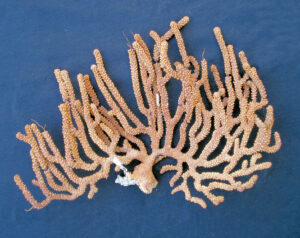California Golden Gorgonian, Muricea californica

 California Golden Gorgonian, Muricea californica. Gorgonian provided by commercial fishermen of the greater Los Cabos area, Baja California Sur, October 2009. Size: 26 cm (10.3 inches) x 16 cm (6.3 inches). Identification courtesy of Dr. David Behrens, Gig Harbor, Washington.
California Golden Gorgonian, Muricea californica. Gorgonian provided by commercial fishermen of the greater Los Cabos area, Baja California Sur, October 2009. Size: 26 cm (10.3 inches) x 16 cm (6.3 inches). Identification courtesy of Dr. David Behrens, Gig Harbor, Washington.


 California Golden Gorgonian, Muricea californica. Underwater photographs taken in Zihuatanejo Bay, Guerrero, February 2020. Photographs courtesy of Ron Woheau, Zihuatanejo, Guerrero. Tentative identification courtesy of Bob Hillis, Ivins, Utah. First and third photographs include excellent photographs of an Acapulco Damselfish.
California Golden Gorgonian, Muricea californica. Underwater photographs taken in Zihuatanejo Bay, Guerrero, February 2020. Photographs courtesy of Ron Woheau, Zihuatanejo, Guerrero. Tentative identification courtesy of Bob Hillis, Ivins, Utah. First and third photographs include excellent photographs of an Acapulco Damselfish.
Phylogeny: The California Golden Gorgonian, Muricea californica (Aurivillius, 1931), is a member of the Gorgonian or Plexauridae Family. It is also known as the Robust Gorgonian and in Mexico as naranja espinazo mar varilla.
Morphology: The California Golden Gorgonian is a colonial organism, that is composed of thousands of individual polyps. They vary in color from light yellow-brown to red-brown, with thick branches that generally stretch across a single plane. They may be brown, golden-brown, reddish-brown, or purplish in color with white polyps that provide a thick busy appearance when extended. Unlike the Brown Gorgonian, Muricae fruticosa, this species maintains a uniform color the entire length of its branches. Annual growth rings can be found in the skeleton of the branches. Gorgonians have flexible branches that often sway with the currents, unlike stony corals, California Golden Gorgonians reach a maximum of 90 cm (2 feet 8 inches) in height.
Habitat and Distribution: The California Golden Gorgonian is found in exposed, current-swept areas, attached to hard surfaces such as coral, pilings, rocks, and wreckage from the intertidal zone to depths up to 455 m (1,500 feet). They range from Southern California to Panama, including the entire Sea of Cortez.
Diet: The California Golden Gorgonian is a sessile suspension feeder, the gorgonian’s diet consists of water-borne prey like plankton, larvae, and eggs.
Predators: Ovulids such as Cyphoma emarginatum or Simnia vidleri feed on the California Golden Gorgonian along with the fish including the Garibaldi, Hypsypops rubicunda.
Reproduction: The California Golden Gorgonian can reproduce asexually through budding and sexually through spawning. During spawning, mass amounts of eggs and sperm are released into the water and fuse into gametes. The larvae will eventually settle on a substrate and begin to form a polyp. From here, a colony grows through cloning (asexual reproduction).
Synonyms: Muricea appressa